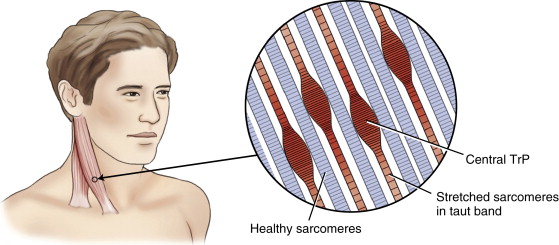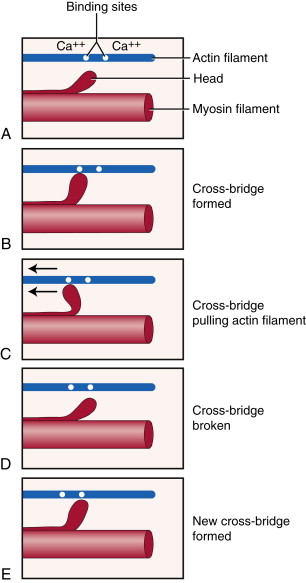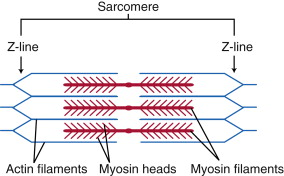Myofascial Trigger Point (TrP)

Myofascial Trigger Point. Permission: Joseph Muscolino. The Muscle and Bone Palpation Manual, with Trigger Points, Referral Patterns, and Stretching, 2nd Edition, 2016, Elsevier.
A myofascial trigger point (TrP, commonly referred to by the lay term muscle knot) is a nodule of tenderness along a taut band of skeletal muscle that may cause pain referral. Massage of the myofascial trigger point results in immediate reduction in trigger point tenderness with reported effects persisting 48 hours, and benefits from multiple cumulative treatments.
The change in tenderness suggests an underlying physiological change, and thus, a study conducted by Albert Moraska and colleagues from Colorado attempted to understand the physiological change within an active myofascial trigger point undergoing trigger point release (ischemic compression). The study measured changes in nutritive (arterial) blood flow as well as interstitial glucose and lactate within an active myofascial trigger point following massage therapy.
Study
The study was a randomized, placebo-controlled trial. Subjects were recruited from the general population and conducted at a research centre affiliated with a university hospital. Twenty-five adults (18-49 years old) with episodic or chronic tension-type headache and an active MTrP in the upper trapezius muscle.
Subjects were randomized to receive a single trigger point release massage consisting of ischemic compression technique or sham ultrasound treatment (as placebo) at an active TrP in the upper trapezius muscle. Microdialysis was used to continuously sample interstitial fluid from the MTrP before, during, and for 60 minutes following treatment.
Outcomes Studied
The primary outcome measure was nutritive blood flow within the TrP as measured by microdialysis ethanol clearance; secondary measures included dialysate glucose, dialysate lactate, and subject discomfort with the procedures. Pressure-pain threshold (PPT) was determined to assess treatment effectiveness.
Results

Sliding Filament Contraction. Myofascial Trigger Point. Permission: Joseph Muscolino. The Muscle and Bone Palpation Manual, with Trigger Points, Referral Patterns, and Stretching, 2nd Edition, 2016, Elsevier.
The results showed that there was no effect of ischemic compression on nutritive arterial blood flow or dialysate glucose level. However, the dialysate lactate level increased for the massage versus sham treatment. Maximum lactate increase over baseline was observed at 60 minutes after massage. An interaction effect on pressure-pain threshold was significant.
The apparent inability of ischemic compression massage to elicit a change in nutritive blood flow within an TrP was unexpected. Active TrP’s are routinely described as localized, tightly contracted regions within muscle that compress blood vessels causing ischemia. The findings indicate that despite physical changes (e.g. tenderness) to the active TrP from ischemic compression massage therapy, it was not sufficient to alter nutritive arterial blood flow.
Digital COMT
Did you know that Digital COMT (Digital Clinical Orthopedic Manual Therapy), Dr. Joe Muscolino’s continuing education video streaming subscription service for massage therapists (and all manual therapists) and movement professionals, has six folders with video lessons on Manual Therapy Treatment, including an entire folder on Stretching, as well as a folder on Pathomechanics, another on Anatomy, and many more? Digital COMT adds seven new video lessons each and every week. And nothing ever goes away! Click here for more information.
Interpretation
The lack of a concomitant change in nutritive blood flow or dialysate glucose suggests an alternate source of glucose, such as intracellular glycogen, was utilized to generate lactate. Increased lactate is indicative of anaerobic respiration and increased demand for cellular energy, possibly related to a cellular stress response, which requires ATP to remove degraded protein that could have occurred with treatment.
The authors concluded that massage of an active TrP affected anaerobic metabolism as represented by an increase in dialysate lactate without change in nutritive blood flow or dialysate glucose.
Comment by Joseph Muscolino

Sarcomere contraction. Myofascial Trigger Point. Permission: Joseph Muscolino. The Muscle and Bone Palpation Manual, with Trigger Points, Referral Patterns, and Stretching, 2nd Edition, 2016, Elsevier.
I find this study interesting for three reasons:
First, it posits the idea that the healthy effect of massage therapy toward reducing a myofascial trigger point might not come from directly increasing arterial blood flow, but rather accomplish the same effect by increasing glucose levels via the release of lactate (which is then used to create glucose, which is then used to create ATP, which is then used to release the actin-myosin cross-bridges and remove the calcium from the sarcoplasmic reticulum) thereby releasing the trigger point sliding filament contraction.
Second, this study utilized a massage therapy technique known as ischemic compression (often called trigger point release therapy). I am not a big fan of this technique to release trigger points. Generally, I prefer deep stroking massage. I believe that deep stroking massage would be more effective toward increasing arterial blood flow to the trigger point (with all its subsequent beneficial effects). Mechanically, this simply makes sense (and neurally, there seems to be little or no evidence that ischemic compression affects any neural loop that would help decreased a trigger point that has already formed). See also Travell and Simons Trigger Point Manual, Volume 1, Second Edition, page 141 for their take on deep stroking massage as an effective manual therapy treatment for myofascial trigger points. Of course, after this study, perhaps deep stroking massage is more effective at releasing lactate levels than at increasing arterial blood flow???
Third, only one treatment was performed. It is entirely possible that a treatment method would be effective if it were given more time to be effective. In other words, utilizing one treatment session might not be an accurate interpretation of the beneficial effects of any manual or movement therapy technique.
This blog post article was created in collaboration with www.terrarosa.com.au.
Digital COMT
Did you know that Digital COMT (Digital Clinical Orthopedic Manual Therapy), Dr. Joe Muscolino’s continuing education video streaming subscription service for massage therapists (and all manual therapists) and movement professionals, has six folders with video lessons on Manual Therapy Treatment, including an entire folder on Stretching, as well as a folder on Pathomechanics, another on Anatomy, and many more? Digital COMT adds seven new video lessons each and every week. And nothing ever goes away! Click here for more information.

